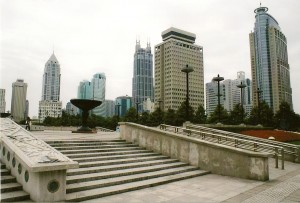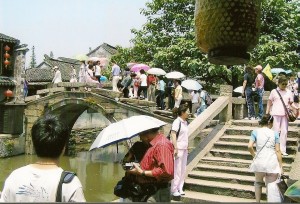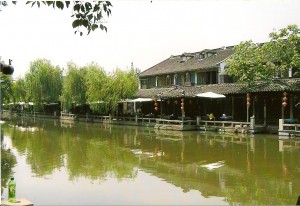The Chinese Threat to the USA
“I am not an advocate for frequent changes in laws and constitutions, but laws and institutions must go hand in hand with the progress of the human mind. As that becomes more developed, more enlightened, as new discoveries are made, new truths discovered and manners and opinions change, with the change of circumstances, institutions must advance also to keep pace with the times. We might as well require a man to wear still the coat which fitted him when a boy as civilized society to remain ever under the regimen of their barbarous ancestors.”
Thomas Jefferson, distinguished 3rd President of the USA (1801-1809), principal author of the American Declaration of Independence, statesman, scholar, inventor, architect, archaeologist and horticulturalist.
The Western & Eastern perception
“Mao Crosses the Yangtse”. It was the biggest headline ever in the Ceylon Daily News on the 23 of August, 1949, and as a schoolboy in Sri Lanka, I read it with wonder and anticipation. The history of the world would never be the same again. A poor oppressed Asian people had defeated an authoritarian semi-feudal regime heavily backed by Western imperial powers – or so we believed in our black and white picture of the world. The Western world was in shock while the colonial or former colonial peoples of Asia overwhelmingly rejoiced. The Western imperial powers that had their own enclaves in Shanghai and other trading ports, with prominent notices in exclusive European suburbs and clubs which bore the sign – “Chinese & Dogs Not Allowed” – found it hard to forgive a Communist China for its impudence. The cry that resonates even now in the West is crudely simple: China is a threat to Western civilization, its democratic values and economic interests. Would they now cross the Pacific Ocean, with long range nuclear missiles as in modern warfare, and attack the US, as many worried Americans fear and their mass media and politicians suggest?
Just last week the European powers in NATO invited Russia to sit down with them on security issues, after having rebuffed earlier Russian attempts to join them for almost two decades. European political leaders and commentators explained the reasons for this about turn in explicit terms on TV: The rapid rise of Asia in recent years, particularly China and India, posed a new potential threat to Europeans. The Russians must now be drawn in as Europeans to face this common threat. Up to now development and prosperity was said to be a win-win situation for everyone. That was when the West was expanding and Asia was mired in poverty. But the development and prosperity of resurgent Asia and the economic downturn in the West now turns this theory on its head!
While we in the West fear the rising Chinese economy[1], condemn its human rights shortcomings[2], imagine that it could be a military threat to US hegemony, little attention has been drawn to the dramatic social transformation that has taken place in China in the last half century. What took 500 years in Europe has been achieved in China in this past half century. We have the United Nations and World Bank statistics on its achievements in literacy and education, health, poverty alleviation, housing, sanitation, access to clean: all these are confirmed data while UN now says that China will probably be the only developing country to achieve all the UN’s Millennium Development Goals by 2015. These by themselves are also considered a threat to Western pre-eminence. The information available to most  Americans, probably the least informed citizens of the world because of the quality of its mass media, makes many of them hysterical at the idea of a rising China.
Americans, probably the least informed citizens of the world because of the quality of its mass media, makes many of them hysterical at the idea of a rising China.
Chinese experiments with government
During the course of the 20th century, the Chinese undertook four of the largest political/social/economic experiments in the history of mankind, within the umbrella of the Chinese Communist Party, involving hundred of millions of participants, and the economic and social ramifications of these resonated around the world: (1) The successful Chinese revolution which took over the country in 1949 after three decades of struggle; (2) The disastrous “Great Leap Forward” of 1958-1962 to collectivize and industrialize which resulted in famine and failure; (3) The destructive “Cultural Revolution” of 1966-1976 to create a pure communist society; (4) The “Socialism with Chinese Characteristics” propelled by Deng Xiaoping after 1978 which has made China the fastest growing economy in the world, now only behind the USA in GDP size. Two gigantic failures and two remarkable successes! Even the two tragic failures on a monumental scale were desperate experiments to leapfrog China from a primitive peasant economy to a modern industrial society by revolutionary leaders with little knowledge at the time of the workings of the world economy.
The military comparison
Does the Chinese government now want to threaten and dominate the rest of the world as most of us are led to believe by our own media and politicians in the West?
Take the issue of military expenditure. The official US expenditure is around $663[3] billion but with supplementary votes for ongoing wars and the physical cost of the war, which includes long-term medical expenses for wounded soldiers, the cost has been calculated at over dollars one trillion a year[4] with the ongoing wars in the Middle East. China is now estimated to spend $98.8 billion. It is less than one tenth the US expenditure with a Chinese population four times that of the USA and a huge land border. China does not maintain overseas bases[5] and has not, in present times, threatened other nations directly, or with the Bush doctrine of “Either you are with us or against us.” It has not invaded any other country since the creation of the Peoples Republic of China. On the other hand, the US and its NATO allies have invaded Vietnam, Lebanon, Iraq and Afghanistan and now threaten to attack Iran. The US, without declaring war, earlier on, bombed Sudan, Libya and Afghanistan. It is involved in a military show of force around the world, with 737 military bases in 63 foreign countries[6]. The Project for the New American Century[7] which advocated US military dominance of the world was a guiding influence for the Bush era wars of this century. One of the key objectives of this document was to “Deter the rise of a great-power competitor”. It identifies China and Russia as the main enemies of the US, among lesser others.
China came in support of North Korea in the Korean War of 1950-53. But this was because victorious US forces approached the Yalu River and General Douglas McArthur was proposing to his government that China should be invaded and even suggested dropping of nuclear bombs on China, proposals his own President Harry Truman rejected. The fledgling Chinese state had suffered enough from foreign intervention and was prepared to defend itself at a time when its military was still poorly equipped.
Chinese occupation of Tibet has been mired in disinformation. Tibet was a Chinese tributary in the past and the Tibetan Panchen Lama visited the Chinese Emperor personally on occasion, even though the journey each way took him over two years at that time. There is a palace built in 1771 not far from the Imperial Summer Palace in Chengde, in imitation of the Potala Palace in Tibet, for the exclusive use of the visiting Dalai Lama and Panchen Lama. I personally visited this palace in 1994 when I was in that region on a UN project in neighbouring Mongolia. After the communist victory, the country feared foreign interference through the weak Tibetan government. Tibet was a feudal theocracy where a sizeable proportion of the people working for the biggest landowners, the Buddhist monasteries, as serfs. Hence the Chinese aimed for a total occupation of Tibet.
After the Chinese revolution, the government entered into negotiations with the government of Tibet for its incorporation within China. There were sections within the Tibetan government that favoured this. But negotiations failed and the Chinese Army crossed the Jinsh River border and occupied the Tibetan border town of Qamdo by use of force. The defeated Tibetan army commander, Ngabo, went to Lhasa to again present the Chinese proposals which were finally accepted after negotiations between the two governments several months later. Tibet agreed to be incorporated within the Peoples Republic of China though there were factions in the government that still disagreed. The Dalai Lama endorsed this agreement. Violent opposition to the Chinese government began only in 1956 in some parts of the country, after the introduction of land reform, led by some of the landowning monasteries. When serious violence spread to Lhasa in 1959, with the CIA providing the rebels with arms and training, the Chinese Army put it down equally violently. Though we may disagree on the use of force, it is undeniable that an oppressive primitive feudal society has been converted since into a modern society with many social and economic benefits for the Tibetan people.
The Taiwan issue is different and more complex. Taiwan was an independent island till it was occupied by the Dutch (1624-1664), Imperial Chinese (1664-1895), Japanese (1895-1945) and was handed back to China by the victors of World War 2 in 1945. In December 1949 the defeated Chiang Kai-shek established Taipei as the provisional capital of a China he no longer ruled. Reciprocally, China was then determined to bring Taiwan under its rule. After many overt military threats against Taiwan that failed, China seems to have realised that it is better to build good relations with economic ties and leave the question of sovereignty unresolved.
During the three early phases of the communist experiments noted here, China did put on a very aggressive posture towards the West which had even blocked its seat in the UN General Assembly till 1971. This was manifested in Chinese state propaganda (crude by modern standards) which referred to the US as a Paper Tiger and local dissidents and critics as Running Dogs of Capitalism. This was accompanied by films and drama depicting the victory of the Chinese Peoples Army over foreign enemies. These started to disappear after President Nixon’s historic visit in 1972 to China to meet with Chairman Mao Zedong and Zou Enlai. But even as early as 1956 the Chinese government had begun to cultivate the Non-Aligned Movement’s developing nations with reciprocal high-level visits and aid projects[8]. Current Chinese propaganda, as shown in the Chinese media and its CCTV channels today, is very sophisticated and attempts to present balanced views in news reporting or analysis.
Chinese pragmatism versus US power politics
Since the introduction of Socialism with Chinese Characteristics, or simply the introduction of a regulated capitalist market economy in China, China has focussed strongly on building a worldwide network of friendly nations. The official Chinese slogan to describe its foreign policy is Harmonious Development of the World. It does not seek domination but economic expansion. Using its vast external resources, which it would otherwise be holding while the value of the US dollar in which it is mostly denominated declines, it has become the major aid donor to most parts of Africa and some parts of Asia and South America. Chinese aid is generous and effective. It does not discriminate against countries because of their political system or their political alliances. In developing countries, Chinese aid is for vital infrastructure development, not for esoteric projects like building democracy or creating civil society. Chinese aid is also cost effective. It does not require lengthy pre-project studies by highly paid consultants and the hire of expensive services. The Chinese allocate a fund and build a project themselves and their costs can be as low as 20% of what it would have cost with Western contractors.
A US Congressional Research Service Study of 25 February 2009 begins:
“In the past several years, the People’s Republic of China (PRC) has bolstered its diplomatic presence and garnered international goodwill through its financing of infrastructure and natural resource development projects, assistance in the carrying out of such projects, and large economic investments in many developing countries.”[9]
In my work in different countries in Africa, I have often heard locals say, “China is our best friend.” But China does not only cultivate developing countries. After the recent financial crisis in Greece, the visiting Chinese President indicated to Greece that they would help to stabilize Greece by buying up to US$50 billion of Greek government bonds when they are issued. Despite the constant criticism of China (human rights, currency manipulation, exploiting poor nations, causing environmental degradation) by the West and particularly US politicians and media, the Chinese refrain from criticising the West. The recent worldwide economic collapse, a Made in USA product, cost China 20 million jobs, and yet it refrains from pointing accusing fingers. Even the annual Human Rights Report of the State Department, which regularly excoriates China, rouses only a mild response with China putting out a modest document on US human rights violations. While criticising China, the US continues to borrow money from China, which is its biggest creditor nation.
It is easy to see who is winning this competition between the USA and China. While the US arrogantly demands compliance even from its NATO allies and threatens recalcitrant developing nations, the Chinese charm offensive backed by massive aid projects has helped it to win friends, gain new raw material sources and establish world-wide trade links.
This wide divergence of foreign policy strategies is due to one singular factor that has not been adequately discussed. The Government of China is organised like a hugely successful business corporation that operates the largest country on earth. The Central Committee of the Communist Party of China is like the Board of Directors and the General Secretary, who is the President, is like the CEO. The shareholders, who are not directly paid dividends but are likely rise in public office, are the 80 million members of the Chinese Communist Party. It draws up national plans, strategies and implementation plans. Like any successful corporation, it has a clear vision for the future. It is highly focussed on national development. It has its rules of conduct to maintain strict order and discipline. The CEOs after Deng Xiaoping are highly-educated middle-aged technocrats, not any of the former octogenarian warriors of the Long March and the Revolutionary War. The CEO and board members are not greedily seeking bonuses and pay rises like US CEOs. They are focussed on long-term national development and their reward is their place in history.
The US government, on the other hand, operates like a dysfunctional democracy. Bitter party rivalry between the two contenders prevents either one from implementing sustainable programs most of the time. The effort is to win power at any cost, with hundreds of millions of campaign funds, hostile and often rude attack advertising. Even programs one party supports it opposes if it is proposed by the other. Additionally, lobbyists and massive corporate and special interest funding of legislators ensure that the common man’s interest is often sacrificed for the benefit of the privileged few. Corporate operated media usually entertains and ensures that ordinary Americans are more ignorant of foreign affairs and their own economy than their counterparts in European countries and other developed nations.
What of the future scenario? The USA has more resources and more high level expertise than any other country. It has attracted the best talent from around the world to maintain its leadership in technical research and development. It has the largest number of the world’s biggest corporations. But the system does not allow it to fully use its talents and resources. The country has now the highest national debt ($13.5 trillion), the highest real unemployment (17.5%) and a declining productivity. Millions have lost their homes and millions more will be losers in the coming years. Can it change the ways it is governed? Can it focus on national development without perpetual wars, now costing a trillion dollars a year? China, on the other hand, has experimented with forms of government in four distinct phases of development. It will certainly keep on modifying and developing its system of government as the general population becomes more and more affluent and demanding. China has been willing to change while the Obama battle cry of Change We Can is lost in the wilderness of partisan politics.
Kenneth Abeywickrama
November 2010
[1] The influential London-based Economist, and most Western economists have been for decades predicting the collapse of the new Chinese economy for not liberalizing its financial institutions, till the 2008 collapse of Western financial institutions for the lack of regulation.
[2] Human Rights has become the most potent weapon to attack developing countries that become too independent of the West. Control of the mass media and international institutions enables the West to pick and choose violators and cover up their own scandals.
[3] Base figures from http://www.globalsecurity.org and Stockholm International Peace Research Institute.
[4] Calculated by Nobel Prize-winning Economist Joseph Stieglitz, among others.
[5] “The String of Pearls” claim, because the Chinese built commercial ports in Pakistan, Sri Lanka and Burma is a canard. It is much coming from the USA which has military bases in 63 countries and 255,065 military personnel overseas. http://www.globalresearch.ca/index.php?context=va&aid=5564
[6] See http://www.globalresearch.ca/index.php?context=va&aid=12824. These are yet 2005 figures and the present number may be more.
[7] See http://www.newamericancentury.org/RebuildingAmericasDefenses.pdf . This misguided view that America can dominate the world by developing extraordinary military prowess has already devastated America’s image around the world and caused it to lose whatever moral authority it possessed.
[8] Between 1971-1973 China built a grandiose international conference centre in Colombo, Sri Lanka, as an outright gift. Shortly after, China built a massive flood protection system in southern Sri Lanka.
